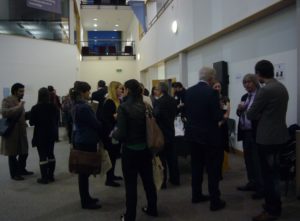On March 21st I attended (what will hopefully become the annual) Birmingham Egyptology Symposium, hosted by postgraduate students at the University of Birmingham. Although I am still a PhD student, currently working 4 days a week means that of late I have felt a little out-of-touch with the current research in the field of Egyptology; this symposium provided the perfect opportunity to rectify this. The turn-out of delegates was most impressive, and it was wonderful to see so many familiar (as well as new!) faces from the international Egyptological community.
—

—
The conference was opened by the university’s own Dr. Tony Leahy, who gave a paper on the sacred landscape of Abydos. This provided an excellent introduction to the day’s proceedings and fit well with the overall theme of the symposium which was ‘Ritual Landscapes’ – a successful choice by the organising committee, giving the wide range of topics that this encompasses, which was demonstrated by the variety of the presentations throughout the day. The symposium was later closed by Dr. Martin Bommas, also of the University of Birmingham, who discussed intangible sacred spaces during magical rituals. This scintillating discussion made us all think about those ‘ad hoc’ (as termed by Bommas) sacred spaces that are set-up for temporary rituals.
All of the presentations were of a high standard, but particular highlights included papers by Kelly Accetta and Colin Reader. Accetta, a PhD student at the University of Cambridge, discussed the range of doorways discovered within the Theban temples and examined how these could affect movement within the ritual landscape of these places. I first heard Accetta give a paper on her postgraduate research at CRE 2012 and it was wonderful to hear her up-to-date conclusions from her work. Reader, an independent scholar, presented a paper on the influence of the landscape of the development of the Egyptian pyramid; I found this particularly interesting and have continued to think about his discussion since – a certain sign that the paper was good! Reader’s work emphasises the importance of a multi-disciplinary approach to the study of Egyptology, in his case using a geological and topographical perspective.
—

Further highlights included the 5 poster presentations provided for perusal throughout the day. These led to further discussion during the tea and lunch breaks, as well as the evening wine reception, all of which were kindly provided for by the BE symposium organising committee. All in all, a fantastic day which successfully allowed postgraduate Egyptologists the opportunity to present and share their research, as well as the chance to network with familiar faces and to meet new friends. I would like to say a huge congratulations to the BE committee for their organisation and commitment to this day; the praise is well deserved and I look forward to attended the event again next year!
—

—
Emily is currently a PhD student at Birmingham with a focus on mourning practices, but she also works part-time as Collections Assistant at the Shakespeare Birthplace Trust in Stratford-upon-Avon.
